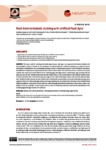Por favor, use este identificador para citar o enlazar este ítem:
http://www.alice.cnptia.embrapa.br/alice/handle/doc/1045048Registro completo de metadatos
| Campo DC | Valor | Lengua/Idioma |
|---|---|---|
| dc.contributor.author | DAMASCENO, J. C. A. | pt_BR |
| dc.contributor.author | SOARES, A. C. F. | pt_BR |
| dc.contributor.author | JESUS, F. N. de | pt_BR |
| dc.contributor.author | CASTRO, J. M. da C. e | pt_BR |
| dc.date.accessioned | 2016-05-16T11:11:11Z | pt_BR |
| dc.date.available | 2016-05-16T11:11:11Z | pt_BR |
| dc.date.created | 2016-05-16 | pt_BR |
| dc.date.issued | 2016 | pt_BR |
| dc.identifier.citation | Nematoda, v. 3, 2016. | pt_BR |
| dc.identifier.uri | http://www.alice.cnptia.embrapa.br/alice/handle/doc/1045048 | pt_BR |
| dc.description | The dyes used for staining nematode egg masses and eggs can cause environmental hazards and human health concerns. The aim of this study was to evaluate different artificial food dyes, as a replacement for acid fuchsin and phloxine B, for staining eggs and egg masses of Meloidogyne javanica from infected tomato plants. Five different combinations of dyes were tested at five concentrations. For control treatments, infected roots were stained with acid fuchsin and phloxine B for coloring eggs and egg masses, respectively. Egg staining with the dyes ponceau 4R with red 40 and ponceau 4R with brilliant blue, at the concentration of 4%, showed results similar to those obtained with acid fuchsin. However, egg masses were effectively stained with ponceau 4R food dyes with red 40 and with ponceau 4R with brilliant blue at all tested concentrations. Ponceau food coloring dyes gave a good contrast for nematode egg masses and egg counting, do not present human health and environmental pollution problems, and can be reused, with less waste being generated in the laboratory. These dyes are low-cost products that are available at most supermarkets, and can efficiently substitute acid fuchsin and phloxine B for staining eggs and egg masses of M. javanica. | pt_BR |
| dc.language.iso | eng | eng |
| dc.rights | openAccess | eng |
| dc.subject | Nematoide das galhas | pt_BR |
| dc.subject | Ovos de nematóides | pt_BR |
| dc.subject | Massas de ovos | pt_BR |
| dc.subject | Coloração | pt_BR |
| dc.subject | Corantes alimentares artificiais | pt_BR |
| dc.subject | Insect | pt_BR |
| dc.title | Root-knot nematode staining with artificial food dyes. | pt_BR |
| dc.type | Artigo de periódico | pt_BR |
| dc.date.updated | 2017-02-16T11:11:11Z | pt_BR |
| dc.subject.thesagro | Nematoide | pt_BR |
| dc.subject.thesagro | Inseto | pt_BR |
| dc.subject.thesagro | Meloidogyne Javanica | pt_BR |
| riaa.ainfo.id | 1045048 | pt_BR |
| riaa.ainfo.lastupdate | 2017-02-16 | pt_BR |
| dc.identifier.doi | 10.4322/nematoda.01816 | pt_BR |
| dc.contributor.institution | JOSILDA CAVALCANTE AMORIM DAMASCENO, Universidade Federal do Recôncavo da Bahia - UFRB, Cruz das Almas BA; ANA CRISTINA FERMINO SOARES, Universidade Federal do Recôncavo da Bahia - UFRB, Cruz das Almas, BA; FÁBIO NASCIMENTO DE JESUS, Universidade Federal do Recôncavo da Bahia - UFRB, Cruz das Almas, BA; JOSE MAURO DA CUNHA E CASTRO, CPATSA. | pt_BR |
| Aparece en las colecciones: | Artigo em periódico indexado (CPATSA)  | |
Ficheros en este ítem:
| Fichero | Descripción | Tamaño | Formato | |
|---|---|---|---|---|
| JoseMauro2016.pdf | 1,75 MB | Adobe PDF |  Visualizar/Abrir |









